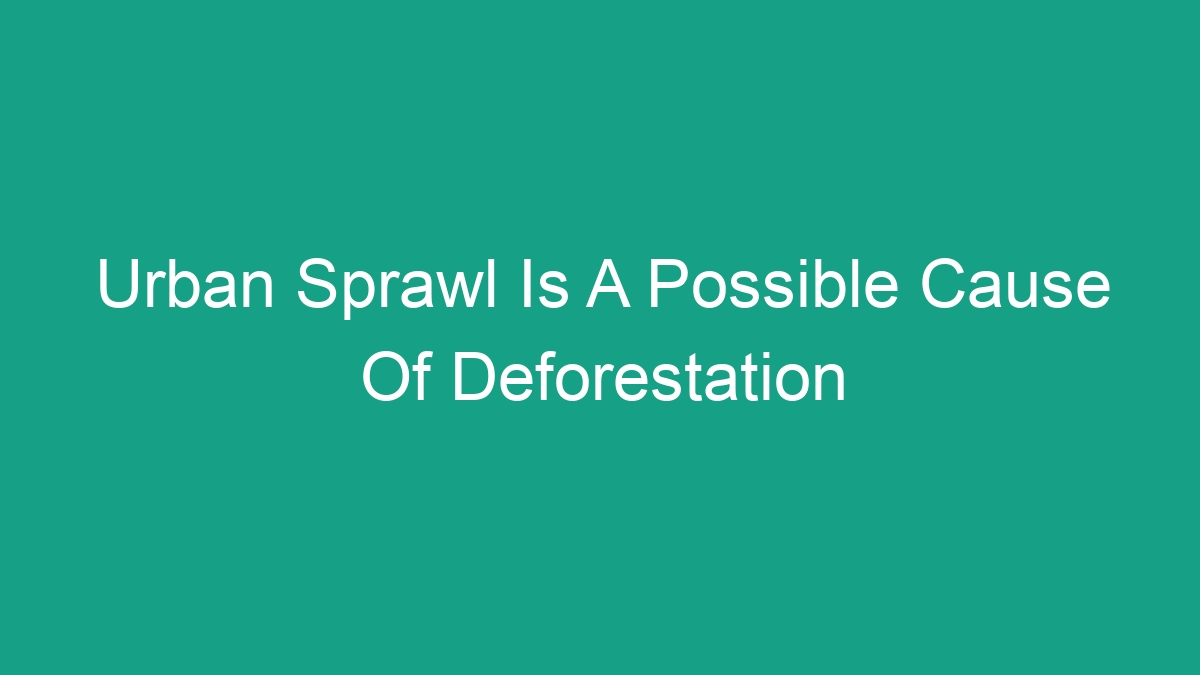
The Dynamics of Urban Sprawl
Urban sprawl refers to the expansion of human populations away from central urban areas into low-density, often-developed areas. This phenomenon is often driven by factors such as population growth, increased automobile usage, and the construction of highways and infrastructure. As a result, urban sprawl leads to the conversion of natural landscapes, including forests, into residential, commercial, and industrial areas.
The Impact of Urban Sprawl on Forests
Urban sprawl poses a significant threat to forests, leading to deforestation through multiple avenues:
- Land Conversion: As cities expand, trees and forests often become casualties. The demand for land for housing, commercial development, and infrastructure leads to the clearing of trees and destruction of forests to make way for urban development.
- Fragmentation of Forests: Urban sprawl can result in the fragmentation of forests, as roads, residential areas, and other developments carve up once cohesive forest landscapes. This fragmentation can have detrimental effects on wildlife and ecosystems, leading to decreased biodiversity and ecological imbalance.
- Increased Human Activity: As urban areas extend into forested areas, they bring with them increased human activity, including logging, agriculture, and recreational use. This heightened human presence often leads to the degradation and destruction of forest ecosystems.
The Role of Policy and Planning
Effective urban planning and policy intervention can play a crucial role in mitigating the impact of urban sprawl on forests:
- Zoning and Land Use Regulations: Implementing and enforcing zoning regulations and land use policies can help steer urban development away from ecologically sensitive areas, such as forests. This can help preserve natural landscapes and reduce the incidence of deforestation due to urban expansion.
- Green Infrastructure: Incorporating green infrastructure, such as parks, green belts, and protected areas, into urban planning can help maintain connectivity and mitigate the effects of fragmentation on forests. These green spaces can also provide important ecosystem services and recreational opportunities for urban residents.
- Smart Growth Strategies: Promoting compact, mixed-use development and encouraging infill development within existing urban areas can help curb urban sprawl and its associated impact on forests. Smart growth strategies prioritize sustainable, efficient land use, which in turn helps protect natural landscapes.
Global Examples of Urban Sprawl and Deforestation
Urban sprawl and deforestation are not isolated issues, and they have been observed in various regions around the world:
- Brazil: The ongoing expansion of cities like São Paulo and Rio de Janeiro has led to extensive deforestation in the Amazon rainforest, as land is cleared for urban development and agriculture.
- United States: Rapid urban sprawl in regions such as the Pacific Northwest and the Southeast has resulted in the loss of forested areas, with consequences for wildlife habitat and ecosystem functioning.
- China: China’s rapid urbanization has resulted in widespread deforestation, particularly in regions such as the Pearl River Delta and the Yangtze River Delta, as cities expand and consume neighboring forested areas.
Public Awareness and Advocacy
Raising public awareness and fostering advocacy efforts are crucial in addressing the nexus between urban sprawl and deforestation:
- Education and Outreach: Educating the public about the environmental impact of urban sprawl and the importance of forest conservation can help garner support for sustainable urban development and conservation initiatives.
- Community Engagement: Engaging local communities and stakeholders in land-use planning and decision-making processes can help ensure that urban development takes into account the preservation of forests and green spaces.
- Advocacy Campaigns: Environmental organizations and advocacy groups can play a key role in advocating for policies and practices that prioritize forest protection in the face of urban expansion.
Conclusion
In conclusion, urban sprawl poses a significant threat to forests and contributes to deforestation through land conversion, fragmentation, and increased human activity. This issue requires concerted efforts in urban planning, policy intervention, and public advocacy to mitigate its impact on forested landscapes. By prioritizing sustainable development, green infrastructure, and community engagement, we can work towards preserving our forests and combating the adverse effects of urban sprawl on the environment.
FAQs
1. What are some possible solutions to mitigate urban sprawl’s impact on deforestation?
Some potential solutions include: implementing zoning and land use regulations, incorporating green infrastructure into urban planning, promoting smart growth strategies, and fostering public awareness and advocacy efforts.
2. What are the global implications of urban sprawl and deforestation?
Urban sprawl and deforestation have far-reaching implications, including loss of biodiversity, habitat destruction, disruption of ecosystem services, and contribution to climate change through carbon emissions from forest clearing.
3. How can individuals contribute to addressing urban sprawl and deforestation?
Individuals can contribute by supporting sustainable development practices, advocating for forest conservation, and engaging in environmentally conscious decision-making in their communities.
By addressing the complexities surrounding urban sprawl and its impact on deforestation, we can collectively work towards a more sustainable and environmentally conscious future.



